|
Printables |
PowerPoints |
Online exercises |
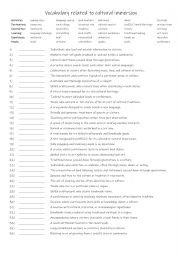
|
A2+-B1 Vocabulary for cultural immersion
Students familiarise themselves with the 30 words and their meanings, then they read the definitions to work out and write in the space provided which one is being described. Answers on page 2.
Level: intermediate
Age: 10-100
Type:
Downloads: 104
|
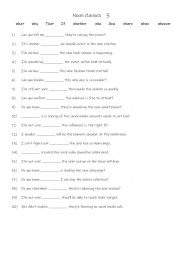
|
10 noun clauses 2
Students complete the gap-fill with the correct word. Each word is used 2 times! Answers on page 2.
Level: elementary
Age: 9-100
Type:
Downloads: 145
|
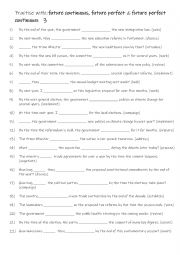
|
B1-B2 Practise with future continuous, future perfect & future perfect continuous 3
Students should learn the future continuous, future perfect, and future perfect continuous tenses to express a variety of future actions and events more clearly. The future continuous describes ongoing actions at a specific future time, the future perfect indicates actions that will be completed before a certain future point, and the future perfect...
Level: intermediate
Age: 10-100
Type: worksheet
Downloads: 135
|
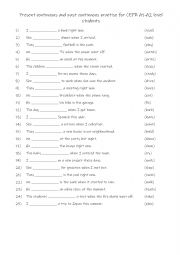
|
Present continuous and past continuous practise
Present continuous and past continuous practise for CEFR A1-A2 level students. Students read the sentences and look for key words to see if the given verb needs to be present or past formation. Answers are on page 2.
Level: elementary
Age: 10-100
Type:
Downloads: 120
|
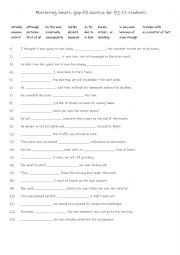
|
Mastering linkers gap-fill exercise for B2-C1 students 1
Linkers help to connect ideas smoothly within and between sentences, making writing and speaking more coherent and easier to follow. By using linkers effectively, students can clarify relationships between ideas, such as cause and effect (e.g., �due to,� �because of�) or contrast (e.g., �although,� �even though�), making their arguments and explana...
Level: advanced
Age: 12-100
Type:
Downloads: 112
|
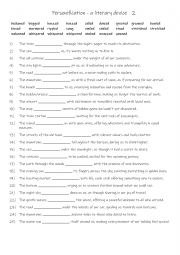
|
B2-C1 Personification - a literary device 2
Learning personification helps students bring their writing to life by giving human qualities to non-human things, making descriptions more engaging and relatable. It enhances creativity, allowing them to craft vivid imagery and evoke emotions in their readers. Understanding personification also deepens their appreciation of literature, as it is ...
Level: advanced
Age: 14-100
Type:
Downloads: 108
|

|
B1-B2 Practise with future continuous, future perfect & future perfect continuous 1
Students should learn the future continuous, future perfect, and future perfect continuous tenses to express a variety of future actions and events more clearly. The future continuous describes ongoing actions at a specific future time, the future perfect indicates actions that will be completed before a certain future point, and the future perfect...
Level: intermediate
Age: 9-100
Type:
Downloads: 116
|
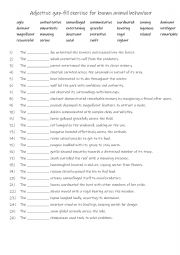
|
B2-C1 Adjective gap-fill exercise for known animal behaviour
Students need to read the sentence, then use one of the adjectives in bold to describe that animal�s normal behaviour. This worksheet is only suitable for B2-C1 level students due to the adjectives and vocabulary. Answers on page 2.
Level: advanced
Age: 12-100
Type:
Downloads: 128
|
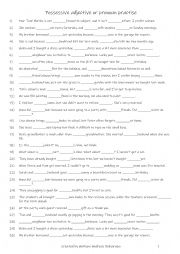
|
A1+-A2 Possessive adjectives & possessive pronouns practise 2
Learning possessive adjectives and possessive pronouns is essential for expressing ownership and relationships clearly and naturally in English. Possessive adjectives (like my, your, his, her) are used before nouns to show who something belongs to, while possessive pronouns (like mine, yours, his, hers) stand alone and replace nouns, avoiding repet...
Level: elementary
Age: 8-100
Type:
Downloads: 105
|
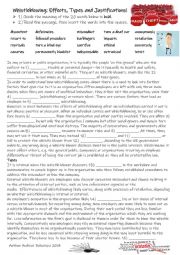
|
Whistleblowing: The Effects, Types and Justifications
850-Word reading article with a 20-word gap fill exercise about whistleblowing. It takes an in-depth look at why people do it, the ramifications for both the whistleblower and the organisation.This sheet is suitable for higher level B1 to C1 students of all ages. An answer sheet is included. For higher level students they could be put in groups to ...
Level: intermediate
Age: 12-100
Type: worksheet
Downloads: 1891
|
|
|
|
|












